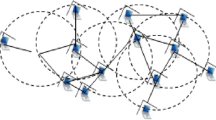Abstract
The synergy between social network analysis and wireless ad hoc network protocol design has recently created increased interest for developing methods and measures that capture the topological characteristics of a wireless network. Such techniques are used for the design of routing and multicasting protocols, for cooperative caching purposes and so on. These techniques are mandatory to characterize the network topology using only limited, local connectivity information—one or two hop information. Even though it seems that such techniques can straightforwardly be derived from the respective network-wide techniques, their design presents significant challenges since they must capture rich information using limited knowledge. This article examines the issue of finding the most central nodes in neighborhoods of a given network with directed or undirected links taking into account only localized connectivity information. An algorithm that calculates the ranking, taking into account the N-hop neighborhood of each node is proposed. The method is compared to popular existing schemes for ranking, using Spearman’s rank correlation coefficient. An extended, faster algorithm which reduces the size of the examined network is also described.







Similar content being viewed by others
Notes
Other weights can be assigned as well, when we want to model energy, latency issues, but these issues are not examined here.
References
Abdallah S (2011) Generalizing unweighted network measures to capture the focus in interactions. Soc Netw Anal Min. doi:10.1007/s13278-011-0018-8
Bavelas A (1948) A mathematical model for group structure. Hum Organ 7:16–30
Bonacich PF (1987) Power and centrality: a family of measures. Am J Sociol 92:1170–1182
Brin S, Page L, Motwani R, Winograd T (1999) PageRank citation ranking: bringing order to the Web. Technical report 1999-66, Computer Science Department, Stanford University
Dimokas N, Katsaros D, Manolopoulos Y (2008) Cooperative caching in wireless multimedia sensor networks. ACM Mobile Netw Appl 13(3–4):337–356
Dimokas N, Katsaros D, Tassiulas L, Manolopoulos Y (2011) High performance, low complexity cooperative caching for wireless sensor networks. ACM Wirel Netw 17(3):717–737
Freeman LC (1979) Centrality in social networks: conceptual clarification. Soc Netw 1:215–239
Freeman LC, Borgatti SP, White DR (1991) Centrality in valued graphs: a measure of betweenness based on network flow. Soc Netw 13:141–154
Gilbert F, Simonetto P, Zaidi F, Jourdan F, Bourqui R (2011) Communities and hierarchical structures in dynamic social networks: analysis and visualization. Soc Netw Anal Min 1(1):83–95
Hui P, Crowcroft J, Yoneki E (2007) BUBBLE Rap: social-based forwarding in delay tolerant networks. In: Proceedings of the ACM MOBIHOC conference, pp 241–250
Hwang W, Kim T, Ramanathan M, Zhang A (2008) Bridging centrality: graph mining from element level to group level. In: Proceedings of ACM SIGKDD, pp 336–344
Katsaros D, Dimokas N, Tassiulas L (2010) Social network analysis concepts in the design of wireless ad hoc networks protocols. IEEE Netw Mag 24(6):23–29
Korn A, Schubert A, Telcs A (2008) Lobby index in networks. http://arxiv.org/abs/0809.0514
Leskovec J, Krause A, Guestrin C, Faloutsos C, VanBriesen J, Glance N (2007) Cost-effective outbreak detection in networks. In: Proceedings of the ACM KDD conference, pp 420–429
Lusseau D, Schneider K, Boisseau OJ, Haase P, Slooten E, Dawson SM (2003) The bottlenose dolphin community of doubtful sound features a large proportion of long-lasting associations. Can geographic isolation explain this unique trait?. Behav Ecol Sociobiol 54:396–405
Maglaras L, Katsaros D (2011) Layered backpressure scheduling for delay reduction in ad hoc networks. In: Proceedings of the IEEE international symposium on a world of wireless, mobile and multimedia networks (WoWMoM)
Nanda S, Kotz D (2008) Localized bridging centrality for distributed network analysis. In: Proceedings of IEEE ICCCN
Newman M (2005) A measure of betweenness centrality based on random walks. Soc Netw 27:39–54
Pathak PH, Dutta R (2010) Using centrality-based power control for hot-spot mitigation in wireless networks. In: Proceedings of the IEEE global telecommunications conference (GLOBECOM)
Perra N, Fortunato S (2008) Spectral centrality measures in complex networks. Phys Rev E 78(036107):036107-1–03107-10
Saravanan M, Prasad G, Karishma S, Suganthi D (2011) Analyzing and labeling telecom communities using structural properties. Soc Netw Anal Min. doi:10.1007/s13278-011-0020-1
Sastry N, Pan Hui P (2011) Path formation in human contact networks. In: Handbook of optimization in complex networks. Springer, Berlin (to appear)
Wasserman S, Faust K (1994) Social network analysis: methods and applications. Structural analysis in the social sciences. Cambridge University Press
Zachary WW (1977) An information flow model for conflict and fission in small groups. J Anthropol Res 33:452–473
Zhang M, Wolff RS (2008) Routing protocols for vehicular ad hoc networks in rural areas. IEEE Commun Mag 46(11):126–131
Acknowledgments
The research was supported by the project “Control for Coordination of Distributed Systems”, funded by the EU.ICT program, Challenge ICT-2007.3.7.
Author information
Authors and Affiliations
Corresponding author
Rights and permissions
About this article
Cite this article
Maglaras, L.A., Katsaros, D. New measures for characterizing the significance of nodes in wireless ad hoc networks via localized path-based neighborhood analysis. Soc. Netw. Anal. Min. 2, 97–106 (2012). https://doi.org/10.1007/s13278-011-0029-5
Received:
Accepted:
Published:
Issue Date:
DOI: https://doi.org/10.1007/s13278-011-0029-5




